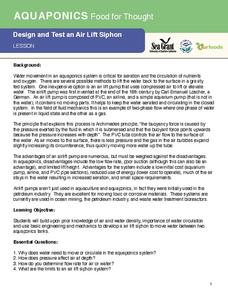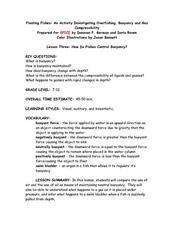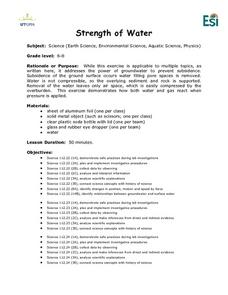University of Southern California
Design and Test an Air Lift Siphon
Build an air lift siphon using your mad physics skills! Learners first investigate the importance of circulating water in aquaponics systems. They then use density to their advantage as they engineer an air lift siphon
Curated OER
Air Pressure
Students examine air pressure. In this air pressure lesson, students perform a series of experiments to evaluate the effects of air pressure.
Curated OER
Floating Fishes: How do Fishes Control Buoyancy?
Playing with balloons, water, oil, and bottles help put this lesson over the top! Participants use air-filled balloons in water tanks to experience gas compression. They also use oil-filled bottles to experiment with buoyancy. Included...
Curated OER
Straw Rockets in Flight! Engineer's Delight
Sixth graders study air compression and how it can power a rocket. In this creative lesson students work with a partner and build a rocket then compare air compressions and graph their results.
Curated OER
Non-Compressibility of Water
Students will observe a property of water. In this inquiry-based properties of air lesson, students observe how a change in water pressure impacts the positioning of an eye-dropper in the water container and they make hypotheses about...
Curated OER
Let's Think About Air
Students explore the concept that air is all around us and identify ways that we can use air, and what air can do. They watch a short video that illustrates some of their findings.
Curated OER
Air Pressure
Students investigate the basic principles of air pressure. In this experimental activity students use materials to create several different experiments that help to explain air pressure and friction.
Curated OER
Force of Air - Does Air do Work ?
Students use a balloon, cardboard support, and wooden ping pong channel to complet an experiment to answer the question "Does Air do Work?" They complete a worksheet to demonstrate knowledge of the concept after the lab.
Curated OER
Bicycle Pump Pressure
Students explain that air pressure applies a force. If any of students have flown in an airplane, they have felt the "popping" of their ears caused by the change in atmospheric pressure because of the altitude changes.
Curated OER
Forces and Balloons
Students investigate the forces of compression, tension and torque on common birthday balloons.
Curated OER
Playground Pounding
Students view photographs depicting soil compression. They use soil and sponges to observe how soil can be compacted, and its implications.
Curated OER
Take a Stab!
Learners construct an experiment to test the rigidity of compressed air and its strength. For this earth science lesson, students are divided into groups, and by putting their thumb over the end of a straw, use the compressed air...
Curated OER
Basics of Archaeology
Students identify what and how to complete an Archaeological excavation is conducted. They identify the transition from one layer to the next more easily if the colors of the layers are different. When creating a dig, the teacher...
Curated OER
Air can do work.
Students replicate the teacher demonstrations by changing the variables and predicting the outcomes.
Curated OER
Scuba Diving
High schoolers discover that scuba diving is more than a sport. It's a science that operationally integrates physics, chemistry, physiology, and oceanography. They perform a simple experiment which simulates the air tanks used in scuba...
Curated OER
Visualizing Density: Density is Non-obvious
Students explore models of density; wooden balls and marbles discussing whether they think the volume and mass are the same or different. They then compare the density of a loaf of bread that is squished and one that is not compressed.
Curated OER
Potato Chips Fragility
Students investigate why some potato chips crumple faster than others. In this physics lessons, students relate the cooking time to potato's fragility. They write a lab report about their findings.
Curated OER
Strength of Water
Students perform experiments using flexible bottles of water and eyedroppers partially filled and placed in the bottle. They record what happens when they tighten the bottle lid and squeeze the bottle.
Curated OER
Relational Causality
Students explore volume and pressure. Through an activity, students discover what happens in situations when volume is increased but no additional air is able to enter the enclosed space. Students create models and explain their...
Curated OER
Robots
Students explore the two kinds of fluids: liquids and gases. They explain that liquids (water), unlike gases (air), cannot be compressed. This property makes them ideal for hydraulic work applications.
Curated OER
Elastic Racquet
Pupils discover the science behind a tennis racket by looking at a simple toy that works in a similar way. After looking at the related mathematical equations, students experiment with the simple toy to find the spring constant k by...
Curated OER
Earthquake Waves
Fourth graders pour three cups of sand on the top of a plastic table near the edge. They tap the table lightly with the rubber mallet. When they tap the table lightly they see the sand ump into the air.
Curated OER
Our Earth
In this Earth's environment worksheet, learners complete a crossword puzzle given 35 clues about a variety of topics related to our Earth. Topics include ecosystems, precipitation, biomes, energy transfer, soil, weathering and rocks.
Curated OER
Earthquakes: Fifth Grade Lesson Plans and Activities
After learning about P waves and S waves, fifth graders view the intensity of earthquakes by examining seismographs and images of earthquake damage. Young scientists then forecasting future quakes by analyzing data about...























